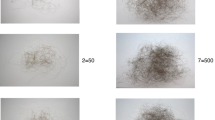Abstract
Hair growth problems can affect human physical and mental health and are of particular relevance during the aging process. In an effort to resolve such problems, we attempted to find plants having hair growth regulation activity and thus collected plant extracts from Tunisia for bioprospecting purposes. Among them, we investigated the Erica multiflora extract to evaluate the hair growth promotion activity by using the MTT (3-(4,5-dimethyl-2-thiazolyl)-2,5-diphenyl-2H-tetrazolium bromide) assay and cell cycle assay on human dermal papilla cells in vitro and an administration assay on mouse dorsal skin in vivo. The results showed that the Erica multiflora extract promotes dermal papilla cell growth and cell cycle with high activity, and induced hair growth in vivo by induction of anagen phase from telogen phase.

Similar content being viewed by others
References
Stenn KS, Paus R (2001) Control of hair follicle cycling. Physiol Rev 81:449–494
Paus R, Cotsarelis G (1999) The biology of hair follicles. N Engl J Med 341:491–497
Ota Y, Saitoh Y, Suzuki S, Ozawa K, Mitsuko K, Imamura T (2002) Fibroblast growth factor 5 inhibits hair growth by blocking dermal papilla cell activation. Biochem Biophys Res Commun 290:169–176
Rho SS, Park SJ, Hwang SL, Lee MH, Kim CD, Lee IH, Chang SY, Rang MJ (2005) The hair growth promoting effect of Asiasari radix extract and its molecular regulation. J Dermatol Sci 38:89–97
Howell BG, Solish N, Lu C, Watanabe H, Mamelak AJ, Freed I, Wang B, Sauder DN (2005) Microarray profiles of human basal cell carcinoma: insight into tumor growth and behavior. J Dermatol Sci 39:39–51
Midorikawa T, Chikazawa T, Yoshino T, Takada K, Arase S (2004) Different gene expression profile observed in dermal papilla cells related to androgenic alopecia by DNA macroarray analysis. J Dermatol Sci 36:25–32
McElwee KJ, Huth A, Kissling S, Hoffman R (2004) Macrophage-stimulating protein promotes hair growth ex vivo and induces anagen from telogen stage hair follicles in vivo. J Invest Dermatol 123:34–40
Komminoth P (1992) Digoxygenin as an alternative probe labeling for in situ hybridization. Diag Mol Pathol 1:142–150
Huang CM, Foster KW, DeSilva T, Zhang JF, Shi Z, Yusuf N, Van Kampen KR, Elmets CA, Tang DC (2003) Comparative proteomic profiling of murine skin. J Invest Dermatol 121:51–64
Hicham H, Nour HB, Mohammed A, Hana SC, Noreddine G, Souliman A (2007) The hypolipidaemic activity of aqueous Erica multiflora flowers extract in Triton WR-1339 induced hyperlipidaemic rats: a comparison with fenofibrate. J Ethnopharm 109:156–160
Esra KA, Erdem Y, Aysegül G (2008) Valuation of anti-inflammatory and antinociceptive activities of Erica species native to Turkey. J Ethnopharm 116:251–257
Harnafi H, Bouanani NEH, Aziz M, Caid HS, Ghalim N, Amrani S (2006) The hypolipidaemic activity of aqueous Erica multiflora flowers extract in Triton WR-1339 induced hyperlipidaemic rats: a comparison with fenofibrate. J Ethnopharmacol 109:156–160
Kawano M, Imamura T, Isoda H (2006) Methods for searching and evaluating effective hair growth regulation factors from Tunisian samples. J Arid Land Stud 15:443–446
Kawano M, Komi-Kuramochi A, Asada M, Suzuki M, Oki J, Jiang J, Imamura T (2005) Comprehensive analysis of FGF and FGFR expression in skin: FGF18 is highly expressed in hair follicles and capable of inducing anagen from telogen stage hair follicles. J Invest Dermatol 124:877–885
Kawano M, Suzuki S, Suzuki M, Oki J, Imamura T (2004) Bulge- and basal layer-specific expression of fibroblast growth factor 13 (FHF-2) in mouse skin. J Invest Dermatol 122:1084–1090
Acknowledgments
This research was performed under the General Framework Agreement on Science and Technology Cooperation between the Ministry of Scientific Research, Technology and Competency Development (MRSTDC) of the Republic of Tunisia and the Alliance for Research on North Africa (ARENA) of the University of Tsukuba, Japan. The agreement, signed on 6 June 2005, is in-line with the UN Convention on Biological Diversity.
Author information
Authors and Affiliations
Corresponding author
Rights and permissions
About this article
Cite this article
Kawano, M., Han, J., Kchouk, M.E. et al. Hair growth regulation by the extract of aromatic plant Erica multiflora . J Nat Med 63, 335–339 (2009). https://doi.org/10.1007/s11418-009-0324-x
Received:
Accepted:
Published:
Issue Date:
DOI: https://doi.org/10.1007/s11418-009-0324-x




